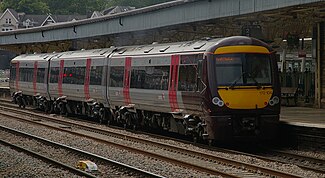Class 170
| British Rail Class 170 Turbostar | |
|---|---|

CrossCountry 170 104 at Newport, on a journey to Cardiff Central from Nottingham
|
|
| In service | 1998–present |
| Manufacturer | ADtranz / Bombardier |
| Family name | Turbostar |
| Replaced |
Class 156 Class 158 Class 205 Class 207 |
| Constructed | 1998–2005 |
| Number built | 122 trainsets |
| Formation | 2 or 3 cars per trainset |
| Operator(s) |
Greater Anglia Abellio ScotRail CrossCountry London Midland |
| Specifications | |
| Car body construction | Welded aluminium. Steel ends. |
| Train length | 2 car: 47.22 m (154 ft 11 in) |
| Car length | 23.62 m (77 ft 6 in) |
| Width | 2.69 m (8 ft 10 in) |
| Height | 3.77 m (12 ft 4 in) |
| Maximum speed | 100 mph (160 km/h) |
| Weight | Varies between 90.41 t (88.98 long tons; 99.66 short tons) (170/1 2 car) to 135.31 t (133.17 long tons; 149.15 short tons) (170/1 3 car) |
| Prime mover(s) | One MTU 6R 183TD13H diesel per car |
| Power output | 315 kilowatts (422 hp) at 1,900 rpm |
| Transmission |
Voith Hydraulic T211rzze to ZF final drive 2 axles driven per car |
| Bogies | Powered: BREL P3-23 Unpowered: BREL T3-23 |
| Braking system(s) | Disc brakes |
| Safety system(s) | AWS, TPWS |
| Coupling system | BSI |
| Track gauge | 1,435 mm (4 ft 8 1⁄2 in) standard gauge |
The Class 170 "Turbostar" is a British diesel multiple-unit (DMU) train built by Bombardier Transportation (and previously ADtranz) at its Derby Litchurch Lane Works. Introduced after privatisation, these trains have operated regional as well as long-distance services, and to a lesser extent suburban services. 122 units have been built.
The class is a development of the design used in the British Rail Class 165 and 166 DMUs known as the Networker Turbos which were built by British Rail Engineering Limited and later ABB Transportation Ltd before that company became part of Bombardier.
Notable features shared are the aluminium alloy frame and Voith transmission as well as the general body shape (the cab ends are similar to those of the Class 168, but not Class 165/166), interior design and door fittings. The final drive is sourced from ZF instead of Gmeinder and the diesel-engine supplier changed to MTU.
The engine and transmission are under the body; one bogie per coach is powered, the other unpowered. All coaches in the set are powered (there are no unpowered trailers). The units can work in multiple with trains in the 15X series, i.e. Sprinters, and with other units of the same class. They are unable to operate in multiple with units in the 16X series due to different wiring arrangements.
Seating arrangements are of both 2+1 (first class) and 2+2 (standard class) formation, and give a seated passenger capacity of between ~100 and ~200 per three-car set (depending on the specifications of the operator). 2-car sets are also operated.
Class 170 units have been categorised into six sub-classes; the basic specifications remain the same (engine, length, transmission, etc.), the differences being the seating arrangements specified by the different operators. Because of the different interior fittings the sub-classes differ in weight from one another by a small amount, up to ~2 tonnes.
...
Wikipedia
